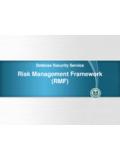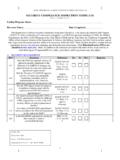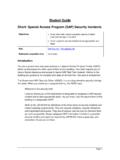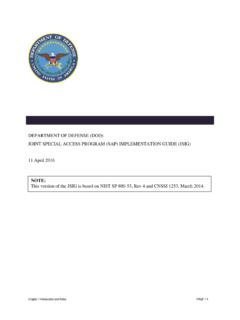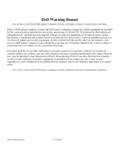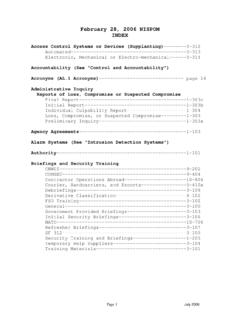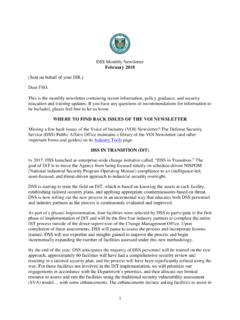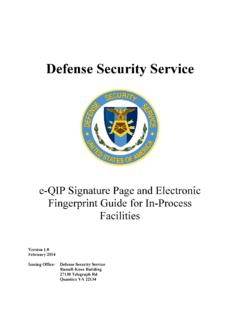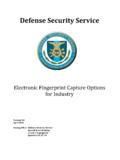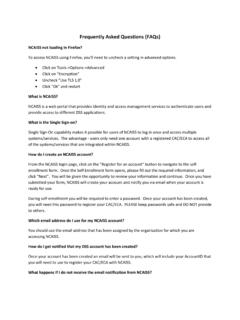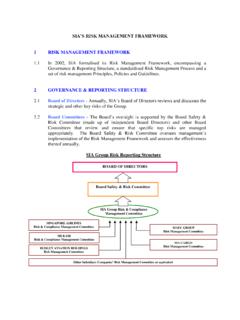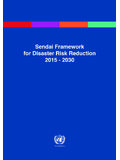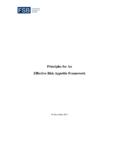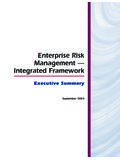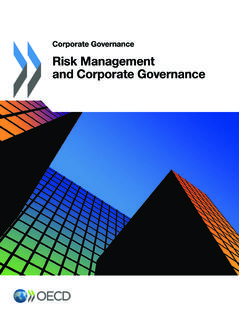Transcription of Risk Management Framework (RMF)
1 1 Risk Management Framework (RMF) Defense Security Service - 2 - What is Risk Management Framework (RMF) It is a unified information security Framework for the entire federal government that replaces legacy Certification and Accreditation (C&A) Processes applied to information systems RMF is a key component of an organization s information security program used in the overall Management of organizational risk - 3 - RMF Policy References - 4 - RMF Process Stakeholders: New Terminology Old Term in the C&A Process New Term in the RMF Process Designated Approving Authority (DAA) Authorizing Official (AO) Regional Designated Approving Authority (RDAA) Regional Authorizing Official (RAO) Office of the Designated Approving Authority (ODAA) NISP Authorization Office Information System Security Professional (ISSP) Security Control Assessor (SCA) Host Node Common Control Provider (CCP) Customer, Government Contracting Activity (GCA) Information Owner (IO) Contractor Information System Owner (ISO)
2 Information System Security Manager (ISSM)* ISSM Information System Security Officer (ISSO)* ISSO Many RMF stakeholder titles have been revised in the transition from C&A. The following table outlines former terms in the C&A process as well as the corresponding new terms in the RMF process. You may continue hearing both sets of terms during the transition to RMF. *Titles will remain the same in RMF. - 5 - Connecting the Dots Old and New Process C&A RMF ODAA Business Management System (OBMS) same same SSP Template same same Categorization Basic, Med, High PLs Low, Mod, High Accessibility Certification Statement same same Risk Acknowledgement/Tailoring-out Risk Acknowledged Tailored-Out MOU/Enhancements MOU ISA Standing-Up Like System Self- Certification Type Authorization Controls NISPOM Refs NIST Controls Approval to Process Accreditation Authorization - 6 - Connecting the Dots Cont.
3 Process C&A RMF Submission Validation within OBMS SSP Certification Statement Profile SSP Certification Statement POAM Risk Assessment Report Assessment Comments on issues Comments Form Security Assessment Report (SAR) - 7 - Key Factors Driving the Transition to RMF Shift from a static, check-the-box mentality to a flexible, dynamic approach to assess and manage risk more effectively and efficiently. Effective and Efficient Risk Management Streamline DSS processes to support the authorization of a cleared contractor s IS processing classified information as part of the NISP.
4 Common Foundation for Information Security Build reciprocity with other federal agencies to develop trust across the federal government through a more holistic, flexible, and strategic process for the risk Management of IT systems. Trust Across the Federal Government Implement a common foundation for information security that aligns to federal government standards for DSS and cleared contractors for a more uniform and consistent approach to manage risk associated with the operation of a classified IS. Streamline DSS processes DSS is implementing the RMF process to assess and authorize Information Systems (IS).
5 - 8 - Roles and Responsibilities in the RMF Process Role Responsibilities Authorizing Official (AO) (formerly the DAA) and Designated Authorizing Official (DAO) (formerly the RDAA) Formally assumes responsibility for operating an IS at an acceptable level of risk to organizational operations, organizational assets, individuals, other organizations, and national security Security Control Assessor (SCA) (formerly the ISSP) Performs oversight of a contractor s IS processing classified information Conducts a comprehensive assessment of the Management , operational, and technical security controls employed within or inherited by an IS to determine the overall effectiveness of the controls Provides an assessment of the severity of weaknesses or deficiencies discovered in the IS and its environment of operation and recommends corrective actions Provides an authorization decision recommendation to the DAO Common Control Provider (CCP) (formerly the Host Node )
6 Assumes responsibility for the development, implementation, assessment, and monitoring of common security controls Information Owner (IO)/Government Contracting Activity (GCA) ( the Customer) Holds statutory, Management , or operational authority for specific information to establish the policies and procedures governing its generation, collection, processing, dissemination, and disposal Establishes the rules for appropriate use and protection of the subject information and retains that responsibility when the information is shared with or provided to other organizations Provides input to the Information System Owners (ISOs)
7 Regarding data - 9 - Roles and Responsibilities in the RMF Process Role Responsibilities Information System Owner (ISO) ( GCA for government systems and ISSM for contractor-owned systems) Holds responsibility for the procurement, development, integration, modification, operation, maintenance, and disposal of an IS Addresses the operational interests of the user community and ensures compliance with information security requirements Information System Security Manager (ISSM) Serves as a principal advisor on all matters, technical and otherwise, involving the security of an IS under her/his purview Ensures physical and environmental protection, personnel security, incident handling, and security training and awareness Monitors a system and its environment of operation to include developing and updating the System Security Plan (SSP)
8 , managing and controlling changes to the system, and assessing the security impact of those changes Must be trained to the level commensurate with the complexity of the contractor s IS or have a local ISSO who is trained. Facility Security Officer Supports the ISSM in their efforts to implement security requirements for classified information systems Ensures physical and environmental protection, personnel security, incident handling, and security training and awareness Information System Security Officer (ISSO) If appointed, supports the ISSM in their efforts to implement security requirements as mandated by NISPOM and DAAPM.
9 Configures and manage the IS configuration - 10 - RMF Process Walk Through: Introduction RMF is a six step process designed to build information security capabilities into Information Systems (IS) throughout the NISP through the application of community best practices for IS Management , operational, and technical security controls. The RMF process is explained in further detail in the ISOM and the DAAPM. 1. Categorize the Information System 2. Select Security Controls 3. Implement Security Controls 4. Assess Security Controls 5. Authorize the Information System 6.
10 Monitor the Information System Risk Management Framework - 11 - RMF Process Walk Through 1. Categorize the Information System 2. Select Security Controls 3. Implement Security Controls 4. Assess Security Controls 5. Authorize the Information System 6. Monitor the Information System Risk Management Framework Step 1: Categorize the IS The ISSM/ISSO categorizes the IS based on the impact due to a loss of confidentiality (moderate/high), integrity (low/moderate/high), and availability (low/moderate/high) of the information or IS according to information provided by the IO.
